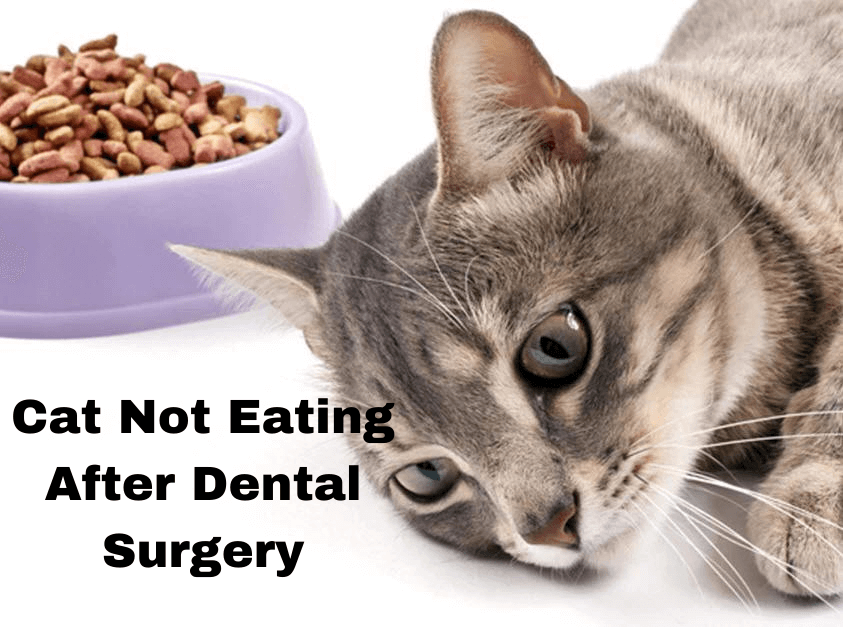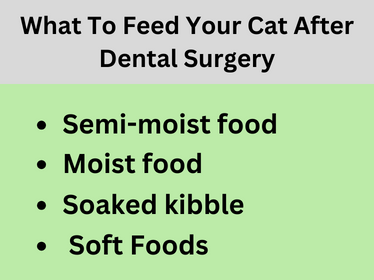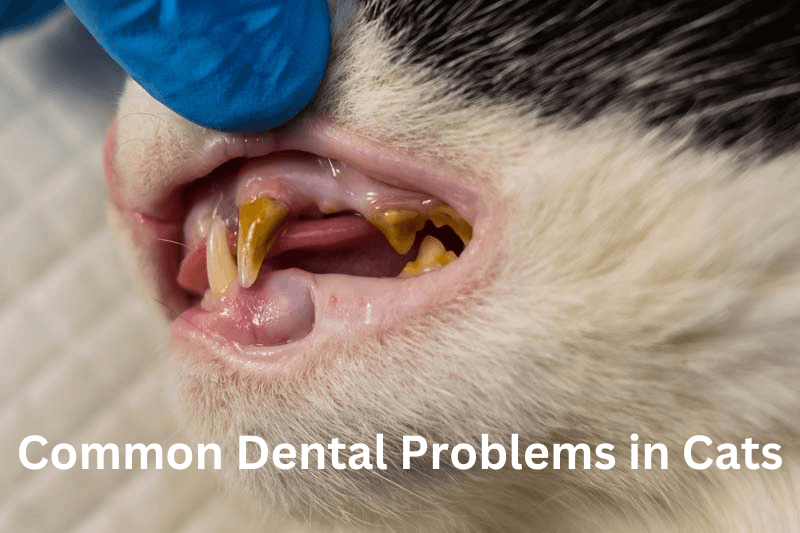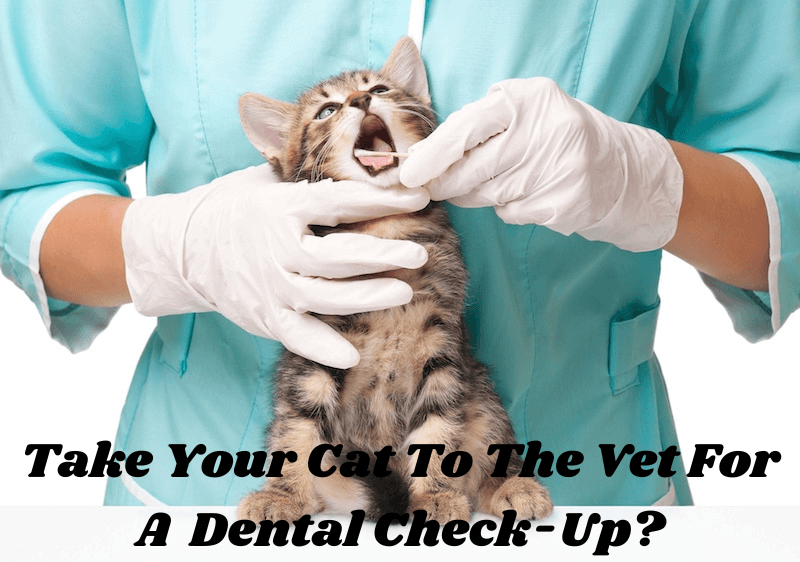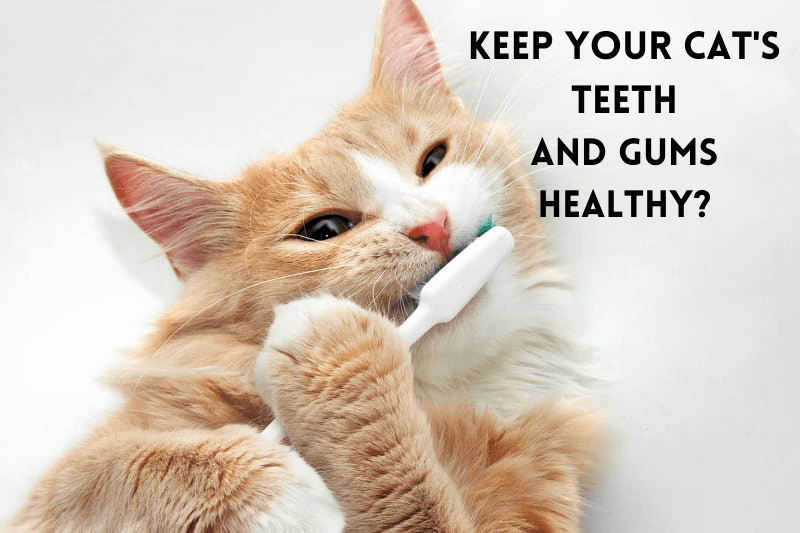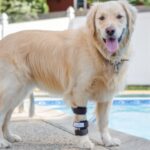Dental surgery is a procedure that involves removing or repairing damaged teeth in cats. Cats may need dental surgery for various reasons, such as tooth decay, gum disease, tooth fracture, or oral tumors.
Dental surgery can improve the oral health and quality of life of cats, but it can also cause some temporary discomfort and side effects. One of the most common problems that cat owners face after dental surgery is a cat not eating after dental surgery.
This can be due to pain, nausea, stress, or changes in taste and smell. Not eating can lead to dehydration, weight loss, and other serious complications in cats. Therefore, it is important to know how to help your cat recover from dental surgery and resume eating as soon as possible.
In this article, we will discuss how long can a cat go without eating after dental surgery, what to feed a cat with tooth pain, and how to manage your cat’s pain after tooth extraction. We hope that this piece of knowledge will provide you with some useful tips and information on how to care for your cat after dental surgery.
Cat Not Eating After Dental Surgery, How to Manage Your Cat’s Pain After Tooth Extraction?
Tooth extraction is a major surgery that can cause a lot of pain and discomfort for your cat and in this situation, a cat does not eat after tooth extraction either. Therefore, it is essential to manage your cat’s pain after the procedure. Here are some pointers on doing that:
- Recognize the signs of pain in cats: Cats are very good at hiding their pain, so you need to be observant and look for subtle clues. Some of the signs of pain in cats are:
- Bad breath: A strong or unpleasant smell from your cat’s mouth can be a sign of infection, decay, or gum disease.
- Difficulty eating or loss of appetite: If your cat avoids eating hard food, drops food from their mouth, or eats less than usual, they may cause tooth pain.
- Drooling or jaw chattering: Excessive saliva or shaking of the jaw can be caused by pain or inflammation in the mouth.
- Pawing at or rubbing their face: Your cat may try to relieve the pain by scratching or rubbing their mouth or face.
- Head shaking or tilt: Your cat may shake or tilt their head to the side where the pain is located.
- Decreased grooming: Your cat may stop grooming themselves or their coat may look unkempt, as grooming can be painful for them.
If you notice any of these signs in your cat, you should take them to the veterinarian for a dental check-up. Your veterinarian can diagnose the cause of the pain and provide appropriate treatment.
Dental problems can affect your cat’s overall health and well-being, so it is important to prevent and treat them as soon as possible.
- Follow the veterinarian’s instructions: Your veterinarian will prescribe pain medication for your cat after tooth extraction. The type and duration of pain medication will depend on the severity of the surgery and your cat’s condition. Some of the common types of pain medication are:
- Non-steroidal anti-inflammatory drugs (NSAIDs), such as meloxicam or rofecoxib, which can reduce inflammation and pain
- Opioids, such as buprenorphine or tramadol, which can provide strong analgesia and sedation
- Local anesthetics, such as lidocaine or bupivacaine, which can numb the nerves and block pain signals
You should follow the dosage and instructions carefully and give the pain medication as directed by your veterinarian. You should also monitor your cat for any side effects or adverse reactions, such as vomiting, diarrhea, lethargy, or breathing difficulties. Make quick contact with your veterinarian if you see any issues.
Do not give human painkillers to cats: You should never give human painkillers to cats, as they can be toxic and fatal for them. For example, aspirin, ibuprofen, acetaminophen, and naproxen can cause severe damage to your cat’s liver, kidneys, stomach, or blood cells.
Even a small dose can be deadly for your cat. Therefore, you should only use the pain medication that is prescribed by your veterinarian and avoid any self-medication.
Managing your cat’s pain after tooth extraction is very important for their recovery and well-being. By following these tips, you can help your cat feel more comfortable and heal faster.
After dental surgery, how long can a cat go without eating?
It is normal for cats to have a reduced appetite or skip a meal after dental surgery. However, they should not go without eating for more than 24-48 hours. This is because cats have a unique metabolism that makes them prone to developing a serious condition called hepatic lipidosis or fatty liver disease.
This happens when the cat’s liver becomes overloaded with fat due to starvation. The symptoms of hepatic lipidosis include jaundice, vomiting, lethargy, and weight loss. If left untreated, hepatic lipidosis can lead to liver failure and death.
Therefore, it is crucial to monitor your cat’s food intake and weight after dental surgery. If your cat does not eat anything within 24 hours or cat does not eat 2 days after surgery less than half of its normal amount, you should contact your veterinarian immediately.
Your veterinarian may prescribe appetite stimulants, anti-nausea medication, or pain medication to help your cat eat. In some cases, your cat may need to be hospitalized and fed through a feeding tube until it recovers.
What to feed your cat after dental surgery
One of the reasons why your cat may not eat after dental surgery is because of tooth pain. Chewing hard or dry food can cause discomfort and irritation to the gums and teeth. Therefore, you should offer your cat.
soft foods that are easy to eat and swallow. Some examples of soft foods are:
- Moist food: This is the best option for cats with tooth pain, as it is soft, moist, and nutritious. You can choose from canned, pouch, or tray food, depending on your cat’s preference and budget. Moist food also helps to keep your cat hydrated, which is important for recovery.
- Semi-moist food: This is another option for cats with tooth pain, as it is softer than dry food but still has some texture and crunch. Semi-moist food usually comes in small pieces or nuggets that are easy to chew and digest. However, semi-moist food may contain more preservatives and artificial flavors than moist food, so you should check the ingredients carefully.
- Soaked kibble: If your cat is used to eating dry food, you can try soaking it in warm water or broth for a few minutes until it becomes soft and mushy. This way, your cat can still enjoy its favorite kibble without hurting its teeth.
To make the food more appealing and tasty for your cat, you can also add some flavor enhancers such as tuna water, chicken broth, or gravy. These liquids can help to stimulate your cat’s appetite and sense of smell, as well as provide extra moisture and nutrients. However, you should avoid adding too much salt, sugar, or fat to the food, as these can be harmful to your cat’s health.
You should also avoid feeding your cat foods that are too hot, cold, spicy, or acidic, as these can aggravate the pain and inflammation in the mouth. For example, you should not feed your cat ice cream, hot soup, chili sauce, or citrus fruits. Instead, you should feed your cat foods that are at room temperature or slightly warm, as these are more comfortable and soothing for the mouth.
Common Dental Problems in Cats
here Some common dental problems in cats are:
- Gingivitis: This is when the gums around the teeth become inflamed or swollen. It is brought on by germs or plaque accumulation on the teeth. It can cause pain, bleeding, and bad breath.
- Periodontitis: This is when the inflammation of the gums spreads to the bone and tissues that support the teeth. It can lead to tooth loss, infection, and damage to other organs.
- Tooth resorption: This is when the tooth structure breaks down and is absorbed by the body. It can cause tooth decay, sensitivity, and pain.
- Dental problems: in cats can affect their overall health and well-being. They can be prevented or treated with regular oral examination and cleaning by a veterinarian.
Cat Acting Strange After Dental Surgery
If your cat has recently undergone dental surgery, you may notice the cat acting strange after dental surgery and some changes in their behavior and appearance. This is normal, as dental surgery can be a stressful and painful experience for your feline friend.
However, some signs of post-surgery complications may require immediate veterinary attention. Here are some tips on how to care for your cat after dental surgery and what to look out for.
What to Expect After Dental Surgery
Depending on the type and extent of the dental procedure, your cat may have some of the following symptoms after surgery:
- Pain and discomfort: Your cat may show signs of pain, such as hiding, hissing, growling, or avoiding contact. They may also paw at their mouth, drool, or have difficulty eating and drinking. Your vet may prescribe pain medication to help your cat cope with the discomfort. Follow the dosage and instructions carefully and do not give your cat any human painkillers, as they can be toxic to cats.
- Bleeding and swelling: Some bleeding and swelling around the surgical site are normal and should subside within a few days. However, if the bleeding is excessive, persistent, or foul-smelling, or if the swelling is severe or spreading, contact your vet immediately, as this could indicate an infection or a complication.
- Stitches and sutures: Your cat may have stitches or sutures to close the wound and promote healing. These may be dissolvable or non-dissolvable, depending on the type of surgery. Your vet will advise you on how to care for the stitches and when to have them removed. Do not try to remove them yourself, as this could cause more damage and pain to your cat. Also, prevent your cat from licking, biting, or scratching the stitches, as this could cause them to come loose or get infected. You may need to use an Elizabethan collar (also known as a cone) to protect the surgical site.
- Diet and hydration: Your cat may have a reduced appetite and thirst after dental surgery, especially if they have pain or difficulty chewing. It is important to keep your cat hydrated and nourished, as this will help them recover faster. Offer your cat soft, moist, or canned food, as this will be easier for them to eat. You may also need to warm up the food slightly or add some water or broth to make it more palatable. Avoid dry, hard, or crunchy food, as this could irritate the wound or damage the stitches. Also, provide your cat with fresh, clean water at all times and monitor their water intake. If your cat is not eating or drinking enough, contact your vet for advice.
How to Help Your Cat Recover
In addition to the above tips, here are some ways to help your cat recover after dental surgery:
- Keep your cat indoors: Your cat may be more vulnerable to infections, injuries, or predators after dental surgery, so it is best to keep them indoors until they are fully healed. This will also prevent them from eating or drinking anything that could harm them or interfere with their recovery.
- Provide a comfortable and quiet environment: Your cat may be more sensitive to noise, light, and stress after dental surgery, so it is important to provide them with a comfortable and quiet place to rest and recover. Provide your cat with a soft bed, blankets, toys, and a litter box. Avoid any loud noises, bright lights, or sudden movements that could startle or upset your cat. Also, limit the interaction with other pets or children, as they may not understand your cat’s condition and may unintentionally hurt them.
- Monitor your cat’s behavior and health: Keep an eye on your cat’s behavior and health after dental surgery and look for any signs of improvement or deterioration. Check your cat’s mouth, gums, teeth, and stitches regularly and note any changes. Also, monitor your cat’s appetite, thirst, weight, energy, mood, and litter box habits. If you notice any signs of infection, complication, or distress, such as fever, lethargy, vomiting, diarrhea, or difficulty breathing, contact your vet immediately.
When to Call Your Vet
While most cats recover well after dental surgery, some may develop complications or infections that require urgent veterinary attention. Call your vet if you notice any of the following signs in your cat:
- Persistent or excessive bleeding from the mouth
- Foul-smelling or discolored discharge from the mouth
- Severe or spreading swelling around the mouth or face
- Difficulty opening or closing the mouth
- Loose or missing stitches or sutures
- Fever, lethargy, vomiting, diarrhea, or difficulty breathing
- No improvement or worsening of symptoms after 48 hours
Dental surgery can be a challenging and stressful experience for your cat, but with proper care and attention, they can recover quickly and comfortably. Follow your vet’s instructions and advice, and do not hesitate to contact them if you have any questions or concerns. Your cat will thank you for your love and support.
if your cat drops blood spots on the bed what are the causes, symptoms, and treatment? To know about it read the below blog post.
cat leaving blood spots on the bed
How often should I take my cat to the vet for a dental check-up?
Dental care is very important for your cat’s health and well-being. According to the American Animal Hospital Association, you should take your adult cat to the vet for a dental check-up at least once a year. This will help to prevent and treat common dental problems in cats, such as gingivitis, periodontitis, and tooth resorption.
Your veterinarian will examine your cat’s teeth and gums and may recommend dental cleaning, x-rays, or tooth extraction if needed. You should also brush your cat’s teeth regularly at home and provide them with dental treats or toys to keep their teeth clean and healthy.
If you notice any signs of dental pain or infection in your cat, such as bad breath, difficulty eating, drooling, or pawing at the mouth, you should contact your veterinarian as soon as possible. Dental problems can affect your cat’s overall health and quality of life, so it is important to prevent and treat them as soon as possible.
Cat Drooling After Tooth Extraction
If your cat has had a tooth extraction, you may notice some drooling from their mouth. This is a common and normal reaction to the surgery, as the saliva helps to keep the wound clean and moist.
However, excessive or persistent drooling may indicate a problem, such as pain, infection, or nerve damage. Here are some tips on how to deal with your cat’s drooling after tooth extraction and when to call your vet.
Why Do Cats Drool After Tooth Extraction?
There are several reasons why cats may drool after tooth extraction, such as:
- Anesthesia: Your cat may have been given anesthesia to numb the pain and relax them during the surgery. This can affect their ability to swallow and control their saliva production, resulting in drooling. This is usually temporary and should wear off within a few hours after the surgery.
- Pain and discomfort: Your cat may experience some pain and discomfort after the surgery, especially if they have multiple or complicated extractions. This can cause them to drool, as they may avoid closing their mouth or licking their lips. Your vet may prescribe pain medication to help your cat cope with the discomfort. Follow the dosage and instructions carefully and do not give your cat any human painkillers, as they can be toxic to cats.
- Inflammation and infection: Your cat may have some inflammation and infection around the extraction site, which can cause swelling, redness, and pus. This can also cause drooling, as the saliva may mix with the pus and blood. Your vet may prescribe antibiotics to prevent or treat the infection. Follow the dosage and instructions carefully and do not stop the treatment without your vet’s approval, as this could make the infection worse.
- Nerve damage: In rare cases, your cat may have nerve damage from the surgery, which can affect their facial muscles and nerves. This can cause drooling, as well as droopy eyelids, ear twitching, or facial paralysis. This may be temporary or permanent, depending on the severity and location of the damage. Your vet may prescribe anti-inflammatory drugs or steroids to reduce the swelling and inflammation around the nerves. Follow the dosage and instructions carefully and monitor your cat’s condition closely.
How to Manage Your Cat’s Drooling After Tooth Extraction
While some drooling is expected after tooth extraction, there are some ways to manage it and make your cat more comfortable, such as:
- Wipe your cat’s mouth: If your cat drooling after tooth extraction, you can use a soft cloth or tissue to gently wipe your cat’s mouth and chin, as this will help to keep them clean and dry.
You can also use a warm compress to soothe the area and reduce the swelling. Do this as often as needed, but be careful not to touch the wound or the stitches, as this could cause pain or infection.
- Offer soft food and water: The cat not eating after dental surgery and may have difficulty eating and drinking after the surgery, especially if they have pain or swelling. It is important to keep your cat hydrated and nourished, as this will help them recover faster. Offer your cat soft, moist, or canned food, as this will be easier for them to eat. You may also need to warm up the food slightly or add some water or broth to make it more palatable. dry, hard, or crunchy food, as this could irritate the wound or damage the stitches. Also, provide your cat with fresh, clean water at all times and monitor their water intake. If your cat is not eating or drinking enough, contact your vet for advice.
How to keep your cat’s teeth and gums healthy?
Keeping your cat’s teeth and gums healthy is very important for their overall well-being. Dental problems can cause pain, infection, and damage to other organs. Here are some tips on how to care for your cat’s oral health:
- Brush your cat’s teeth daily or regularly with a cat-friendly toothbrush and toothpaste. This is the best way to prevent plaque and tartar buildup, which can lead to gingivitis and periodontitis.
- Feed your cat a high-quality diet that is teeth-friendly and avoids sticky or sugary foods. Some veterinarians recommend a raw or BARF diet for cats, as it can help keep their teeth clean and strong.
- Give your cat dental treats, chews, or toys that help remove plaque and tartar. Some products are approved by the Veterinary Oral Health Council (VOHC) for their effectiveness in reducing dental disease.
- Use dental gels, sprays, rinses, or supplements that can reduce bacteria and inflammation in your cat’s mouth. Some products contain chlorhexidine, zinc, aloe vera, or baking soda as active ingredients.
- Add sea kelp or other natural ingredients that can improve your cat’s dental health. Sea kelp can help prevent plaque formation and provide minerals for healthy teeth and gums.
- Visit the vet regularly for annual checkups and professional cleaning if needed. Your veterinarian can examine your cat’s teeth and gums and may recommend dental X-rays or tooth extraction if necessary.
Conclusion
In this article, we have discussed how to help if your cat not eating after dental surgery. We have covered the following topics:
- How long can a cat go without eating after dental surgery and what are the risks of prolonged fasting
- What to feed a cat with tooth pain and how to make the food more appealing and comfortable
- How to manage your cat’s pain after tooth extraction and what pain medication to use
Cat won’t eat after surgery, dental surgery can be a stressful and painful experience for your cat, but with proper care and attention, most cats recover well and resume eating within a few days. You should monitor your cat’s food intake, weight, and behavior after the surgery and follow the veterinarian’s instructions carefully.
If you have any questions or concerns, you should always consult your veterinarian for advice and guidance. We hope that this article has provided you with some useful tips and information on how to care for your cat after dental surgery.
FAQs About The Cat Not Eating After Dental Surgery
Q. How long can a cat go without eating after dental surgery?
Answer: It is normal for cats to have a reduced appetite or skip a meal after dental surgery. However, they should not go without eating for more than 24-48 hours to avoid the risk of hepatic lipidosis.
Q. What signs indicate that a cat is in pain after dental surgery?
Answer: Signs of pain in cats after dental surgery may include bad breath, difficulty eating, drooling, pawing at the face, head shaking, decreased grooming, and a tilted head. If observed, it’s crucial to consult a veterinarian for a dental check-up.
Q. How to manage a cat’s pain after tooth extraction?
Answer: Follow the veterinarian’s instructions for prescribed pain medication, which may include non-steroidal anti-inflammatory drugs (NSAIDs), opioids, or local anesthetics. Never give human painkillers to cats, and monitor for any side effects or adverse reactions.
Q. What should I feed my cat with tooth pain after dental surgery?
Answer: Offer soft foods like moist food, semi-moist food, or soaked kibble to ease discomfort. Add flavor enhancers like tuna water or chicken broth. Avoid foods that are too hot, cold, spicy, or acidic, as they can worsen pain and inflammation.
Q. How often should I take my cat to the vet for a dental check-up?
Answer: According to the American Animal Hospital Association, adult cats should have a dental check-up at least once a year. Regular dental care, including professional cleaning and home brushing, can prevent and treat common dental problems in cats.

